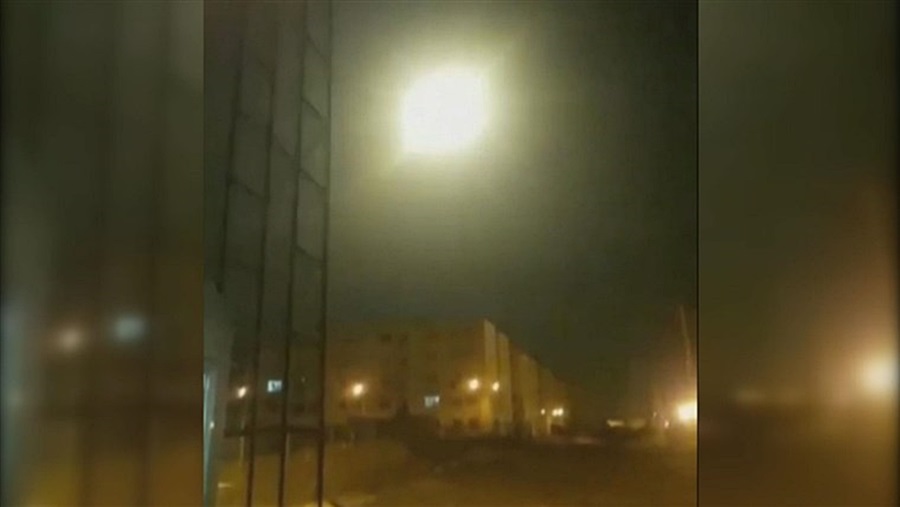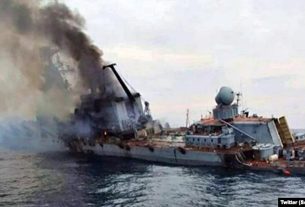Fri 10 January 2020:
A newly surfaced video appears to show the moment a Ukrainian airliner was hit by a missile before crashing not far from Iran’s airport in Tehran on Wednesday.
The video, first reported by the New York Times newspaper and CNN, is consistent with statements made by Canadian, US and UK officials, who said intelligence indicated that an Iranian missile brought down the airliner, a conclusion dismissed by Iran.
The video shows a small explosion in the sky over Parand, the suburb where the Ukrainian airliner first stopped transmitting its signal, the New York Times reported.
The plane continues to fly for several minutes before turning back towards the airport, the newspaper said. It then exploded and crashed. A loud explosion can be heard.
Using geolocation technology and other techniques, Bellingcat, an independent international collective of researchers and citizen journalists, established the video was taken in Parand.
The New York Times and CNN said their news outlets were sent the video by internet-freedom researcher Nariman Gharib, who said he obtained it from another individual.
The Ukrainian flight that crashed just outside the Iranian capital of Tehran was hit by an Iranian anti-aircraft missile system, three sources tell Newsweek.
We are analyzing this new video supposedly showing a mid-air explosion. By our initial estimation, the video shows an apartment block in western Parand (35.489414, 50.906917), facing northeast. This perspective is directed approximately towards the known trajectory of #PS752. pic.twitter.com/nDvjRIkFU4
— Bellingcat (@bellingcat) January 9, 2020
Some airline analysts said the evidence points to downing by an anti-aircraft missile.
Richard Aboulafia, aerospace analyst and vice president of the US-based Teal Group, told Al Jazeera that the possibility of the relatively new plane crashing “due to the aircraft or engine is between zero and one percent”.
It sounds very likely that their radar and satellite picked events up that match the missile theory.
MARK ZEE, FOUNDER OF OPSGROUP
“Planes don’t just take off and explode on their own,” he added. “There is such a thing as uncontained turbine failure, but it does not look like this.”
Aboulafia described the Ukrainian plane as “blowing up, like a grenade” and having “a lot of kinetics” that suggest a shootdown by anti-aircraft missiles.
“The mysterious Iranian government message saying this was mechanical failure was just bizarre,” Aboulafia said, referring to the lack of pilot communication, black-box data or ground-control information before that announcement. “The optics speak of nothing good.”
Mark Zee, founder of Opsgroup, an aerospace intelligence firm, said that a clearer cause is emerging but is “still not concrete, because it’s back-channel stuff to the media in the US”.
“I suspect the US will have to come out with a statement on it, from the military side,” he told Al Jazeera. “It sounds very likely that their radar and satellite picked events up that match the missile theory.”
“Those systems are designed to look for anti-aircraft and missile activity,” added Zee, referring to the timing of the incident among other factors such as the lack of a distress call to air-traffic control, an abrupt loss of navigation signals, no indications of an attempt to return to Tehran’s airport and widely scattered wreckage.
“If the eyewitness video is verified, then that also lines up with the [missile] theory,” Zee added. “Finally, the images from the Iranian news agency of the aircraft parts show something that looks a lot like projectile damage, but higher-resolution images would be needed.”
The Ukrainian International Airlines Boeing 737-800, flying to Kiev and carrying mostly Iranians and Iranian-Canadians, crashed on Wednesday shortly after taking off from Tehran’s Imam Khomeini airport, killing all 176 people on board.
Tehran won’t give Boeing or US black boxes
Under the rules of the 1944 Chicago Convention on International Civil Aviation that created a global regime for air travel overseen by the United Nations, Iran’s air accident investigation branch automatically takes charge.
Ordinarily, because the jet was US-made, the US has the right to be accredited to the inquiry.
Black boxes from Boeing planes are often sent to Boeing’s US suppliers, but that is looking unlikely in this case.
“We will not give the black boxes to the manufacturer (Boeing) and the Americans,” Iran’s Civil Aviation Organization chief Ali Abedzadeh told Iran’s Mehr News Agency.
Iran could ask a third country to help analyse black-box data, especially if reading the information is technically difficult due to badly damaged casings.
Canada could end up playing a key role in the investigation.
On Thursday, Canada’s Transportation Safety Board (TSB) announced that it has accepted Iran’s invitation “to attend the accident site”, and is making arrangements for its representatives to travel to Tehran.
Think your friends would be interested? Share this story!





